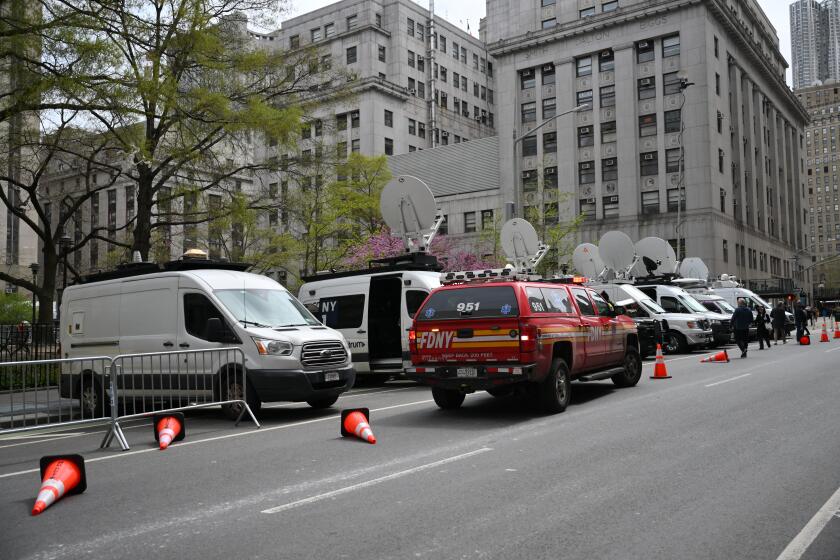Highway Bill Is Rolled Out
Congress may have the answer to your traffic woes: a study of tunneling under South Pasadena to complete the long-stalled Long Beach Freeway extension, a widening of the San Diego Freeway and a carpool lane for the Golden State Freeway.
Those are among the 2,800 projects packed into a 900-page, $275-billion transportation bill headed for House approval.
The bill -- written chiefly by Transportation Committee Chairman Don Young (R-Alaska) -- got its first public exposure Wednesday when the lawmaker took it to his colleagues on the panel, who moved it to the full House by voice vote.
Young originally had proposed $375 billion in transportation assistance over six years, but budgetary and political realities forced him to come down to $275 billion.
The bill ultimately sent to President Bush probably will fall somewhere between $275 billion and the $318 billion already approved by the Senate. That will leave Bush with a difficult choice: to kill the bill with his veto or to sign a bill substantially more expensive than his requested ceiling of $265 billion.
“This bill is a real test of the Republicans’ ability to crack down on spending,” said Robert L. Bixby, executive director of the Concord Coalition, an Arlington, Va.-based budget watchdog group. “If the rank-and-file decide that their desire for pork-barrel projects exceeds their concern about the deficit, the Republican leadership may end up with tire marks on its face.”
Stephen E. Sandherr, chief executive officer of the Associated General Contractors of America, said his construction trade group would lobby to get as close as possible to the Senate figure. He said it would have “the immediate benefit of creating jobs at a time when our economy needs the boost.”
The bill, expected to be considered next week, would provide about $225 billion for highway programs and about $51 billion for transit programs, including buying buses and extending rail lines.
California would get the most money of any state, with more than $17 billion, about $1.8 billion more than it received under the previous six-year bill.
But the state would continue to get back less money than its residents pay in federal gasoline taxes, a sore point for Gov. Arnold Schwarzenegger.
“We know the California delegation will work very hard to make sure that California gets its fair share,” said Patrick Dorinson, deputy secretary for communications for the California Business, Transportation and Housing Agency.
California would receive $5.5 billion for transit, a $1.9-billion increase from the previous bill.
The first glimpse of projects packed into the bill showed that they reflected the personal and parochial interests of lawmakers -- particularly Transportation Committee members.
Although most of the money in the bill would be distributed to states to spend as they saw fit, lawmakers included “high-priority” projects big and small. They range from $10 million for strengthening the Golden Gate Bridge to better withstand an earthquake to $85,000 for installation of a traffic signal and ramps on the San Bernardino Freeway at Walnut Grove Avenue in Rosemead.
The bill would provide nearly $30 million to build grade crossings in eastern Los Angeles County and Orange County to speed freight trains carrying goods from the ports of Los Angeles and Long Beach without delaying street traffic.
It also would provide $6.7 million for widening the San Diego Freeway, but does not specify where; $5.6 million toward widening the Golden State Freeway from California 91 to the Long Beach Freeway; and $1.5 million for adding carpool and truck lanes to the Golden State Freeway through the Santa Clarita Valley. The funds may not fully pay for the projects, but their designation signifies lawmakers’ hopes that state and local officials will supplement state or other federal funds.
The list also includes $2 million to improve beach access and “accommodate increasing pedestrian traffic” in Manhattan Beach; $3.5 million for a “streetscape” project on Central Avenue in Watts; $1 million for “traffic calming” measures for vehicles exiting the Long Beach Freeway into Long Beach; and $575,000 for construction of a bikeway along a stretch of the Los Angeles River in the San Fernando Valley.
Also included is $2.5 million to widen and add turn lanes to Firestone Boulevard in Downey; $2 million for the construction of an interchange on Interstate 10 at Palm Drive; $1.2 million for “streetscape” improvements on Laurel Canyon and Victory boulevards in North Hollywood; $5 million for upgrading the Kanan Road interchange on the Ventura Freeway in Agoura Hills; $3 million to widen Washington Boulevard in Commerce; and $3 million for the feasibility study for the Long Beach Freeway tunneling project.
The bill also would provide $5 million to connect missing segments of a bike and pedestrian trail around the Monterey Bay National Marine Sanctuary.
Lawmakers said they consulted local transportation officials to make sure the projects that received funding were worthy. But in some cases, the projects reflect their personal interests. Rep. Bob Filner (D-San Diego) secured $1 million for a pet project: studying construction of a high-speed magnetic-levitation train between San Diego and an airport he would like to see built in Imperial County.
The number of projects also could increase.
Rep. Gary Miller (D-Diamond Bar) secured $14 million to lower the railroad tracks that parallel Orangethorpe Avenue in Orange County in order to reduce the noise from trains as well as speed their movement without slowing automobile traffic. The project is expected to cost $450 million, and Miller is seeking additional funding.
Citing California’s budget troubles, Miller said, “Many of my state’s communities don’t have enough money to fix potholes, let alone expand capacity to meet the needs of our growing population. Passage of this important bill will sustain our nation’s economic growth and ensure our constituents are provided with the safest and most efficient transportation network possible.”
More to Read
Get the L.A. Times Politics newsletter
Deeply reported insights into legislation, politics and policy from Sacramento, Washington and beyond. In your inbox three times per week.
You may occasionally receive promotional content from the Los Angeles Times.







